Are the present pricing policies of the major pharmaceutial compaines ethically justifiable? explain.

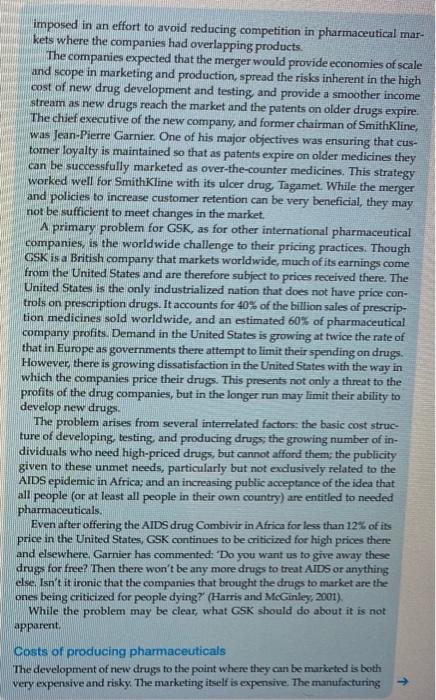
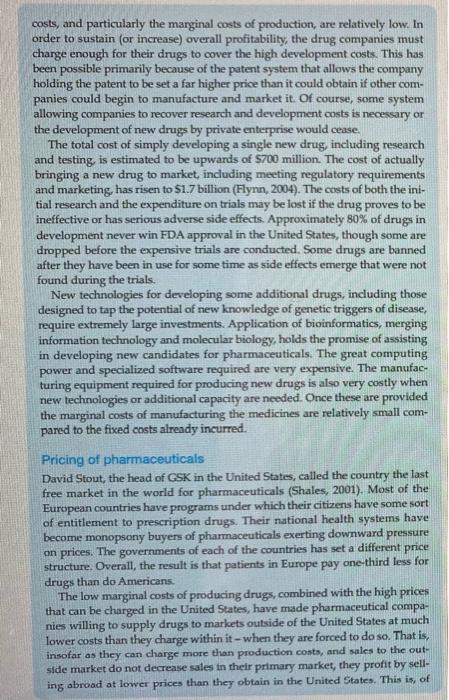
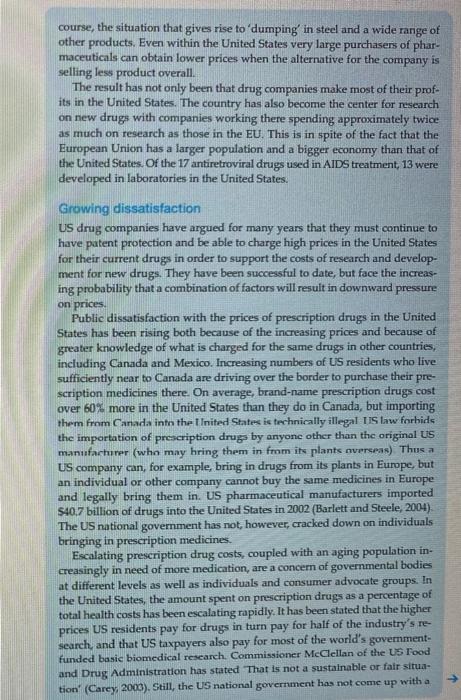
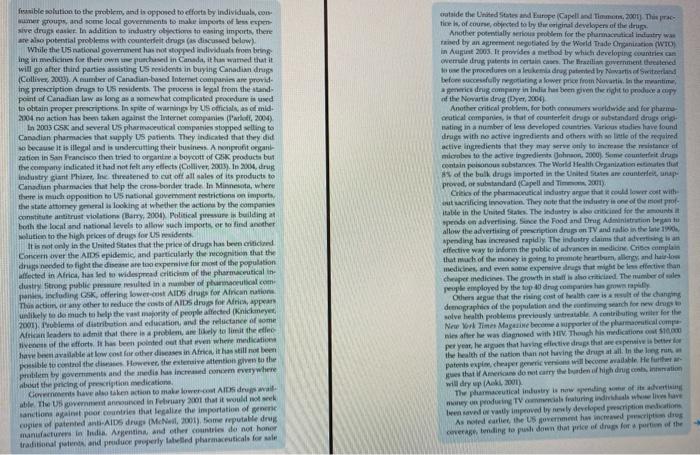
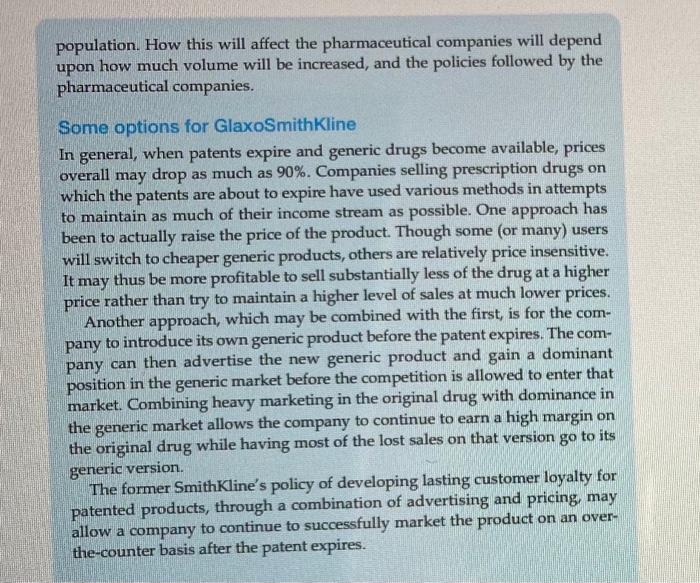
In August 2010, Britain's GlaxoSmithKline PLC (GSK) was facing the possi- bility that its highly profitable diabetes drug Avandia would have to be with- drawn from the US market. Sales of Avandia had already been prohibited in Germany, and the drug was being investigated in another European country. The problem was the possibility of an increased risk of heart attacks when taking the drug. GSK had already set aside 2.3 billion for its potential risk from lawsuits (The Lex Column, 2010). An even bigger problem facing the company, and the whole pharmaceuti- cal industry, had been resolved with little public concern earlier in the year. The US comprehensive health care plan, passed in 2010, had not mandated ceiling prices for prescription drugs purchased under the plan It did provide for some ceilings on government reimbursements for medicines under the government program, but otherwise left companies free to set their own prices. The US is the only country among the industrialized nations that does not effectively have price controls on prescription drugs. Had the US imposed them, it would have had a major impact on the industry. Because of the lack of price controls, the American market provides 60% of the profits of the whole international pharmaceutical industry. The many other problems facing GSK, and the industry as a whole, are discussed below, after discussing some of the challenges faced by GSK in its formation. Forming GlaxoSmithKline Britain's GlaxoSmithKline, the second largest pharmaceutical company in the world, was formed on 27 December 2000 by the merger of Glaxo Wellcome PLC and SmithKline PLC, one British company and one American company. The merged company had over 7% of the world market for ethical (prescription) drugs. GSK has had an increasing trend in both sales and prof- its since its formation, except for a small drop in sales in 2007. Total turnover (sales) were 28.4 billion in 2009. Because of the international nature of the companies involved, the pro- posed merger had required approvals by three governments as well as the stockholders of the companies involved. The European Commission had granted approval in May 2000, stockholders of both companies had endorsed it in July, and both the US Federal Trade Commission and the British High Court had given their approvals in December 2000. As a condition of approv- merger, the three governmental authorities had required the compa- nies to divest themselves of specific patents and drugs. These conditions were ing the imposed in an effort to avoid reducing competition in pharmaceutical mar- kets where the companies had overlapping products. The companies expected that the merger would provide economies of scale and scope in marketing and production, spread the risks inherent in the high cost of new drug development and testing and provide a smoother income stream as new drugs reach the market and the patents on older drugs expire. The chief executive of the new company, and former chairman of SmithKline, was Jean-Pierre Garnier. One of his major objectives was ensuring that cus- tomer loyalty is maintained so that as patents expire on older medicines they can be successfully marketed as over-the-counter medicines. This strategy worked well for SmithKline with its ulcer drug. Tagamet. While the merger and policies to increase customer retention can be very beneficial, they may not be sufficient to meet changes in the market. A primary problem for GSK, as for other international pharmaceutical companies, is the worldwide challenge to their pricing practices. Though GSK is a British company that markets worldwide, much of its earnings come from the United States and are therefore subject to prices received there. The United States is the only industrialized nation that does not have price con- trols on prescription drugs. It accounts for 40% of the billion sales of prescrip- tion medicines sold worldwide, and an estimated 60% of pharmaceutical company profits. Demand in the United States is growing at twice the rate of that in Europe as governments there attempt to limit their spending on drugs. However there is growing dissatisfaction in the United States with the way in which the companies price their drugs. This presents not only a threat to the profits of the drug companies, but in the longer run may limit their ability to develop new drugs. The problem arises from several interrelated factors the basic cost struc ture of developing, testing, and producing drugs, the growing number of in- dividuals who need high-priced drugs, but cannot afford them, the publicity given to these unmet needs, particularly but not exclusively related to the AIDS epidemic in Africa, and an increasing public acceptance of the idea that all people (or at least all people in their own country) are entitled to needed pharmaceuticals Even after offering the AIDS drug Combivir in Africa for less than 12% of its price in the United States, GSK continues to be criticized for high prices there and elsewhere. Garnier has commented: 'Do you want us to give away these drugs for free? Then there won't be any more drugs to treat AIDS or anything else. Isn't it ironic that the companies that brought the drugs to market are the ones being criticized for people dying? (Harris and McGinley, 2001) While the problem may be clear, what GSK should do about it is not apparent Costs of producing pharmaceuticals The development of new drugs to the point where they can be marketed is both very expensive and risky. The marketing itself is expensive. The manufacturing costs, and particularly the marginal costs of production, are relatively low. In order to sustain (or increase) overall profitability, the drug companies must charge enough for their drugs to cover the high development costs. This has been possible primarily because of the patent system that allows the company holding the patent to be set a far higher price than it could obtain if other com- panies could begin to manufacture and market it. Of course, some system allowing companies to recover research and development costs is necessary or the development of new drugs by private enterprise would cease. The total cost of simply developing a single new drug, including research and testing is estimated to be upwards of $700 million. The cost of actually bringing a new drug to market, including meeting regulatory requirements and marketing, has risen to $1.7 billion (Flynn, 2004). The costs of both the ini- tial research and the expenditure on trials may be lost if the drug proves to be ineffective or has serious adverse side effects. Approximately 80% of drugs in development never win FDA approval in the United States, though some are dropped before the expensive trials are conducted. Some drugs are banned after they have been in use for some time as side effects emerge that were not found during the trials. New technologies for developing some additional drugs, including those designed to tap the potential of new knowledge of genetic triggers of disease, require extremely large investments. Application of bioinformatics, merging information technology and molecular biology, holds the promise of assisting in developing new candidates for pharmaceuticals. The great computing power and specialized software required are very expensive. The manufac- turing equipment required for producing new drugs is also very costly when new technologies or additional capacity are needed. Once these are provided the marginal costs of manufacturing the medicines are relatively small com- pared to the fixed costs already incurred. Pricing of pharmaceuticals David Stout, the head of GSK in the United States, called the country the last free market in the world for pharmaceuticals (Shales, 2001). Most of the European countries have programs under which their citizens have some sort of entitlement to prescription drugs. Their national health systems have become monopsony buyers of pharmaceuticals exerting downward pressure on prices. The governments of each of the countries has set a different price structure. Overall, the result is that patients in Europe pay one-third less for drugs than do Americans. The low marginal costs of producing drugs, combined with the high prices that can be charged in the United States, have made pharmaceutical compa- nies willing to supply drugs to markets outside of the United States at much lower costs than they charge within it - when they are forced to do so. That is, insofar as they can charge more than production costs, and sales to the out- side market do not decrease sales in their primary market, they profit by sell- ing abroad at lower prices than they obtain in the United States. This is, of course, the situation that gives rise to 'dumping in steel and a wide range of other products. Even within the United States very large purchasers of phar- maceuticals can obtain lower prices when the alternative for the company is selling less product overall. The result has not only been that drug companies make most of their prof- its in the United States. The country has also become the center for research on new drugs with companies working there spending approximately twice as much on research as those in the EU. This is in spite of the fact that the European Union has a larger population and a bigger economy than that of the United States. Of the 17 antiretroviral drugs used in AIDS treatment, 13 were developed in laboratories in the United States. Growing dissatisfaction US drug companies have argued for many years that they must continue to have patent protection and be able to charge high prices in the United States for their current drugs in order to support the costs of research and develop- ment for new drugs. They have been successful to date, but face the increas- ing probability that a combination of factors will result in downward pressure on prices. Public dissatisfaction with the prices of prescription drugs in the United States has been rising both because of the increasing prices and because of greater knowledge of what is charged for the same drugs in other countries, including Canada and Mexico. Increasing numbers of US residents who live sufficiently near to Canada are driving over the border to purchase their pre- scription medicines there. On average, brand-name prescription drugs cost over 60% more in the United States than they do in Canada, but importing them from Canada into the United States is technically illegal US law forhids the importation prescription drugs by anyone other than the original US manufacturer (who may hring them in from its plants overseas) Thus a US company can, for example, bring in drugs from its plants in Europe, but an individual or other company cannot buy the same medicines in Europe and legally bring them in. US pharmaceutical manufacturers imported S407 billion of drugs into the United States in 2002 (Barlett and Steele, 2004) The US national government has not, however, cracked down on individuals bringing in prescription medicines. Escalating prescription drug costs, coupled with an aging population in- creasingly in need of more medication, are a concern of governmental bodies at different levels as well as individuals and consumer advocate groups. In the United States, the amount spent on prescription drugs as a percentage of total health costs has been escalating rapidly. It has been stated that the higher prices US residents pay for drugs in turn pay for half of the industry's re- search, and that US taxpayers also pay for most of the world's government- funded basic biomedical research Commissioner McClellan of the US Food and Drug Administration has stated that is not a sustainable or fair situa- tion" (Carey, 2003). Still, the US national government has not come up with a feasible solution to the problem, and is opposed to efforts by individuals, con sumer groups and some local governments to make imports of less open sive drug cake. In addition to industry objections to easing import, there are also potential problems with counterfeit drugs (as discussed below) While the US national government has not stopped individuals from bring Ingin medicines for their own tre purchased in Canada, ithu wamed that it will go after third parties assisting US residents in buying Canadian drugs Collive, 2003). A number of Canadian-based Internet companies are provid ing prescription drop to US residents. The process is legal from the stand point of Canadian law as long as a somewhat complicated procedures wed to obtain proper prescription. In spite of warning to US officials, as od mld. 2004 no action has been taken against the Internet companies all, 2004) In 2003 SK and several US pharmaceutical companies stopped selling to Canadian pharmacies that supply US patients. They indicated that they did so because it is illegal and is undercutting their business. A nonprofit organi ration in San Francisco then tried to organize boycott of GSK product but the company indicated it had not felt any elect(Colliver, 2013). In 2, Industry giant Phiner, Inc treatened to cut off all sales of its products to Canadian pharmacies that help the cross-border trade in Minnet, where there is much opposition to US national government restrictions on imports the state attomeyeral is looking at whether the action by the companies constitute antitrust violations (Barry, 2001) Political pressure in building both the local and national levels to allow suchy importer to find another Nolution to the high prices of drugs for US residents It is not only in the United States that the price of drug has been criticund Concem over the AIDS epidemic and particularly the cognition that the drugs needed to fight the dire o expensive for most of the population affected in Africa, has led to widespread criticism of the pharmaceutical dustry strong public premore resulted in a number of pharmaceutical.com ponending SK, sering low-cost Alt drugs for African nation This action any other reduce the ants of AIDS druge for Africa, appear unlikely to do much to help the way of people afected knickmeyer 2001). Woblem of distribution and education, and the reluctance of some African leaders to admit that there is a problemi, are dy to limit theo of the efforts. It has been pointed out that even where medicatie have det low cost for other diseases in Africa, it has still not be posible to control the dise However, the extensive attention given to the problem by governments and the media laincom verywhere about the pricing of prescription medication Comments have take action to make lower AIDS drugwa able. The US governance in fuary 2001 that it would sanctions against poor countries that legalize the importation of copies of patented an AIDS drugs (M.N., 2001), some reputable drug manufacturer in India, Argentina, and other countries de not honor traditional potent and produce properly alulled pharmaceuticals for sale utside the United States and pe (Capellid Timm.2001). The th, of cred to try the original developers of the Another potially in poblem for the plural industry w Taised by an agreement etiated in the World Trade Organi (WTO) in 2003. It provides a method by which developing countries an overde drug patients in certaines The Hivernment and to use the procedures on alkemudug puid lry Newaris Switzerland before successfully going a lower price from Novartis. In the meantime eneric drug company in India has been given the right to produce a py of the Novartis drug (Dyer, 2004) Another critical problem, for both worldwide and fee pharma rutical companies, is that of counterfeit drup or standard der Hating in a number of developed countries. Various sodies have found drugs with no active ingredients and others with little of the required active ingredients that they may rently to the mistance of mieres to the active ingredients Johnson, 2000. Sem conferit dup contain poisonous substances. The World Health Organimatut of the bulk drogs imported in the United States Counterfeitura proved, or standard (Capell and Time Cres of the pharmaceutical industry are that could low cost with ut sacrificing inovation. They note that the industry is one of our prof. Itable in the United States. The Industry is whered for the amount spends on advertising Since the Food and Drug Administration be allow the advertising of prescription dupan TV and radio in the late 19 spending has increased rapidly the industry claims that advertise was effective way to inform the public of advances in medicine. Che complain tlut much of the money is going to me hartbum, eng and low medicines, and even the expensive nugs that might be ton fective than che per medicines. The growth install i social. The number of sales people employed by the top 40 de companies us grown Others age that the ring cost of healthcare issued the changing denographies of the population and the wing search for wdrugs to solve health problem previously the contributing will for the New York Times Magazine become a supported the plural.com niese he was diagnosed with HIV. Though his medication on per year, here that having live drugs that we expensive the health of the nation than not having the digital in the long patents explochaper wrice will become wadable He further es the American do not carry the banden hiding in will dry up (Arki The pharmaceutical Industry is now unding of the weeting money on producing TV curing individuelle len ved atly improved by developed in me As earlier the US government in primus coverage lending to push down the price of drug for pertin of the population. How this will affect the pharmaceutical companies will depend upon how much volume will be increased, and the policies followed by the pharmaceutical companies. Some options for GlaxoSmithKline In general, when patents expire and generic drugs become available, prices overall may drop as much as 90%. Companies selling prescription drugs on which the patents are about to expire have used various methods in attempts to maintain as much of their income stream as possible. One approach has been to actually raise the price of the product. Though some (or many) users will switch to cheaper generic products, others are relatively price insensitive. It may thus be more profitable to sell substantially less of the drug at a higher price rather than try to maintain a higher level of sales at much lower prices. Another approach, which may be combined with the first, is for the com- pany to introduce its own generic product before the patent expires. The com- pany can then advertise the new generic product and gain a dominant position in the generic market before the competition is allowed to enter that market. Combining heavy marketing in the original drug with dominance in the generic market allows the company to continue to earn a high margin on the original drug while having most of the lost sales on that version go to its generic version The former SmithKline's policy of developing lasting customer loyalty for patented products, through a combination of advertising and pricing, may allow a company to continue to successfully market the product on an over- the-counter basis after the patent expires












